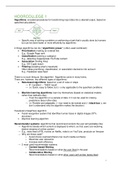HOORCOLLEGE 1
Algorithms: encoded procedures for transforming input data into a desired output, based on
specified calculations
→ Specific way of solving a problem or performing a task that’s usually done by humans
but can be done faster or more efficiently by algorithms
4 things algorithms can do (‘’algorithmic power’’) (often used combined):
• Prioritization (making an ordered list)
E.g., Google Page rank
• Classification (picking a category)
E.g., detecting inappropriate YouTube content
• Association (finding links)
E.g., OK-Cupid match
• Filtering (isolating what’s important)
Often takes prioritizing, classification, or association decisions into account
E.g., Facebook news feed
There is no such thing as ‘the algorithm’. Algorithms come in many forms.
There are, however, two different types of algorithms:
• Rule-based algorithms: based on a set of rules or steps
→ IF ‘condition’ – THEN ‘result’
→ (+) Quick, easy to follow, but (–) only applicable to the specified conditions
• Machine learning algorithms: learn by themselves (based on statistical models
rather than defined rules)
→ Train the algorithm on a sample of data → it can be used for making
predictions about other data
→ (+) Flexible and adaptable, (–) but need to be trained and (–) black-box (= we
don’t understand why the algorithm makes the decision)
Facebook’s DeepFace algorithm
• Facial recognition system that identifies human faces in digital images (97%
accuracy)
• Machine learning algorithm
Recommender systems: algorithms that recommend content the user will (probably) like
→ Algorithms decide which content is displayed to whom, so that users are receiving
distinct streams of online content
→ E.g., news feed of FB, movies on Netflix, video’s on YouTube, products on Amazon
→ Why are these used?
o Avoid choice overload (there’s too much media out there)
o Maximise user relevance
o Increase work efficiency
→ 3 most used recommender systems:
o Content-based filtering:
Recommendations based on what the user liked in the past
o Collaborative filtering:
Recommendations based on what other users with similar tastes liked
1
, o Hybrid filtering: content-based + collaborative filtering + additional elements
such as demographics
→ Mostly used
→ E.g., Netflix’s recommender system)
Algorithmic appreciation: people rely more on algorithms than on people despite the fact
that they don’t understand algorithms
→ Automation bias: blind faith in automation
→ Humans are imperfect, whereas computers are objective, rational, reliable, etc.
→ E.g., GPS system, automatic pilot, spelling checker
→ We trust the TomTom more than aunt Donna sitting next to us
Algorithmic aversion: tendency to prefer human judgments over algorithmic decisions,
even when the human decisions are clearly inferior
→ People are averse because they don’t understand the algorithmic process and they
think humans are easier to understand
→ Less tolerance for errors from algorithms than from humans (e.g., GPS leads you to
traffic jam → you get angrier than if a human led you to a traffic jam)
→ Algorithmic anxiety: lack of control and uncertainty over algorithms
Whether you appreciate algorithms depends on many other factors:
• Type of task & level of subjectivity in decisions
o Mechanical, rational tasks (e.g. optimizing my work schedule) → Algorithm
o When the task is more subjective (e.g. hiring someone) → Human
• Individual characteristics
o Young, highly educated women perceive algorithms as the most useful;
Old, low educated men perceive algorithms as the least useful
o The more technical knowledge and the less privacy concerns you have,
the more useful and fairer you will find an algorithm
• Etc. (more research needed!)
Algorithms should be seen as tools that can support rather than replace humans in
decision-making. The power of veto remains important: humans should always have the
power to interfere.
People have a very low algorithmic awareness; they don’t know how algorithms curate
content. When asked, people come up with their own theories about how algorithms work on
Facebook:
• The Theory of Loud and Quiet Friends: loud friends that post a lot are more often in
my feed than shy friends that post very often
• The Global Popularity Theory: the more friends someone has, the more likely their
posts will be in my feed because they are more popular
• The Fresh Blood Theory: recently added friends’ content is more often on your feed
• The OC Theory: people that post original content (instead of sharing other people’s
content) are more often in your feed
• The Randomness Theory: the algorithm randomly shows you content
HOORCOLLEGE 2
Online behavioural advertising: “The practice of monitoring people’s online behaviour and
using the collected information to show people individually targeted advertisements”
(Boerman, Kruikemeier & Borgesius, 2017)
→ Based on online behaviour, not demographics etc.
2




